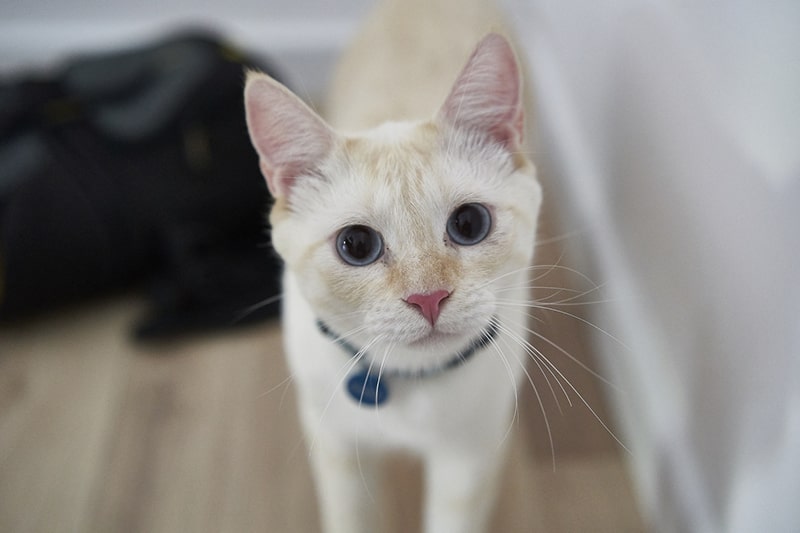Financing Your Pet's Care: How to Budget, Save, and Get Help with Veterinary Expenses
Learn all about financing your pet's care. From routine to unexpected, we'll help you navigate the options available for covering pet healthcare costs.
As pet parents, we view our kitties as sweet, cuddly companions who love to play, snuggle, nap, and eat treats. Of course, it's important to remember that cats – no matter how adorable – are animals with some of their natural instincts still in play. These instincts can sometimes manifest in territorial behavior problems.
Just like you and me, your cat needs to know that they have an adequate food supply and are safe from life-threatening conflicts in order to feel secure in their daily life. The innate desire for those two conditions is what leads many cats to exhibit territorial behavior.
By marking their territory, your cat is telling other cats to keep away – which makes your kitty feel calmer and safer. Unfortunately, this marking can cause some unpleasant behaviors, such as hissing, spraying (urine marking), stalking, or even attacking members or your family, furry or otherwise.
Territorial behavior is most common in homes with multiple cats. While any cat can exhibit this type of behavior, adult males who have not been neutered are the most likely to display it. In addition to sexual maturation, other causes include stress, a change in routine, a new house, the introduction of a new pet, or a lack of socialization when your furry friend was young.
Because cats tend to be more solitary than dogs (and can be a little more selective regarding friendships, too!), their territorial behavioral issues can feel more overwhelming than your dog's. Just be patient and remember that with proper training and support, you can help your kitty overcome this unwanted behavior.

When you think of territorial cat behavior, you might picture two hissing, yelping cats fighting over their turf. While aggression between cats can certainly be a sign, territorial behavior can present in a variety of ways. Here are some signs your feline friend may be trying to mark their territory:
Some pet parents confuse urine marking with regular litter box problems. However, unlike simply eliminating outside of the litter box, urine marking is actually a form of communication your cat uses to let other cats (whether they are really in your home or just a perceived threat) know whose turf they are on.
When marking this way, your kitty sprays a mix of urine and other chemicals, usually onto a vertical surface. You can tell the difference from typical litter box issues because there will be less in volume and the odor will be noticeably more pungent.
Clearly, urine marking is a way of claiming ownership. Your kitty may also do this by patrolling your home, blocking doorways, or rubbing their bodies (especially their cheeks, chins, and tails) on everything inside your house – even you and your family members!
If you have more than one cat, your pals may have a hard time sharing your home, and this could result in aggressive behavior like hissing, swatting, chasing, and even full-on attacks. Often, one cat will be the aggressor and will present a stiff, straight-legged posture, upright ears, and constricted pupils. Meanwhile, the less dominant cat will crouch, tuck their head, curl their tail, and have flattened ears with dilated pupils.
Knowing these signs can help you keep your kitties safe, as you should never let them fight it out. If you do discover your cats fighting, you can disrupt them by clapping, whistling, or making another startling noise.
Although less common, cats can also become aggressive toward humans. This can include stalking, chasing, swatting, hissing, and growling. It can even escalate to scratching and biting. Your cat may single out a certain family member or visitor and remain friendly with others.
If your cat does become aggressive with you, and you sustain scratches or bites, make sure you are familiar with the symptoms of cat scratch fever. Although rare, this bacterial infection sometimes requires antibiotics.

If your cat starts acting territorial, one of the most important things to remember is that you shouldn't punish your pal for their behavior. This will only make what is already a stressful situation for you kitty worse, and the chances are that your cat's territorial behavior will only increase with yelling or harsh discipline.
Be patient, focus on reward-based training, and take things very slowly if you are reintroducing pets. This is a transition you cannot rush. Give each pet their own confined space for as long as it takes, complete with their own food and water bowls, beds, and litter boxes.
It's also a good idea to contact your veterinarian, especially if your cat has been aggressive, since injury or illness can sometimes be behind cat aggression. You can also seek help from a professional trainer or behaviorist if your kitty's territorial behavior persists, and you need backup.

The most effective thing you can do to prevent territorial behavior is to have your cat spayed or neutered. If you haven't done so already, it’s a good idea to schedule this procedure as soon as possible.
Here are some additional ways you can help your pal feel more secure and be less likely to exhibit territorial behavior:
Territorial behavior can take months to overcome and may require some intervention. Luckily, ASPCA Pet Health Insurance plans include behavioral coverage.
Is your kitty covered? Get a quote now!
The information presented in this article is for educational and informational purposes only and does not constitute or substitute for the advice of your veterinarian.